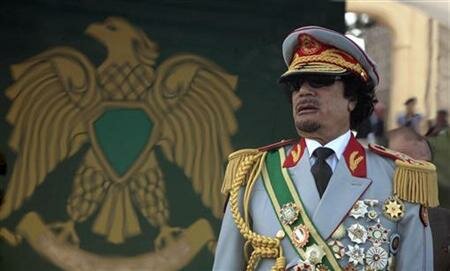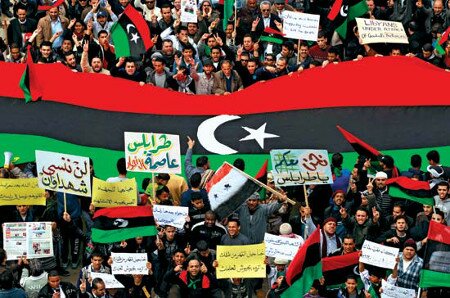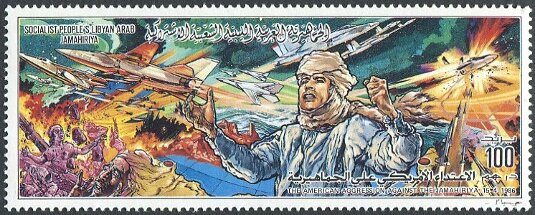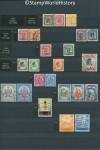ليبيا

Libya
Kingdom

Libya
Jamahiriya

Libya
Transitional government
Quick reference
General issues: Kingdom 1951-1969, Arab republic 1969-1977, Socialist peoples Arab republic 1977-2011, Transitional government 2011-Present
Country name on general issues: Libya, L.A.R., Socialist Peoples Libyan Arab Jamahiriya
Currency: 1 Pound = 1000 Millièmes = 480 MAL (Military Authority Lira) = 960 Francs 1951-1952, 1 Pound = 1000 Millièmes 1952-1972, 1 Dinar = 1000 Dirhams
Population: 1 035 000 in 1951, 6 202 000 in 2013
Political history Libya
Ottoman rule
Libya is located in northern Africa. Libya has a long history. Having been part of the Roman Empire for centuries Libya is conquered by the Arabs in the 7th century. The Arabs bring their culture, their language and Islam. In the 16th century Libya becomes part of the Ottoman Empire of which, in the second part of the 19th century, it forms the vilayet – province – of Tripolitania. The population is of Berber, Arab and Turkish origin and is almost fully Arabized. After the Italo-Turkish war, Italy, in 1912, takes possession of Ottoman Tripolitania – de jure Ottoman Tripolitania is ceded to Italy in 1923.
Italian rule
Italy divides Ottoman Tripolitania into the colonies of Italian Cyrenaica and Italian Tripolitania and the Military Territory of Southern Libya. The Italian possessions in Libya are, together, often referred to as ‘Italian North Africa’ and ‘Italian Libya’. In 1934, Italian Cyrenaica and Italian Tripolitania are grouped together, known officially officially as Italian Libya from then on. The territory of Italian Libya is extended on a number of occasions. By 1935, the borders are established as we know them until today – with the exception of the Aouzou strip that will be disputed until 1994.
Allied administration
In WWII Libya will develop into a major theater of war. Fortunes change between 1940 and 1943, but events eventually lead to Allied victory and the eviction of Italy from Libya in 1943. Libya is divided into three occupation zones. The zones of Cyrenaica and Tripolitania are administered by the British, the zone of Fezzan & Ghadames by the French. Libya is formally ceded by Italy in 1947. Directly after WWII, there are several options for the future of Libya – ranging from a divided Libya to a unified state. In 1949, the United Nations step in. A resolution is passed stating that Libya is to gain independence as a unified state by 1951. The independent kingdom of Libya is proclaimed in 1951. Muhammed Idris – emir of emirate of Cyrenaica proclaimed just prior to Libyan independence – is crowned king of Libya.
Independent Libya

Muammar Qaddafi in 2009 attending the 40th anniversary of his coming to power and ……
Initially, Libya is governed as a federal state – reflecting the differences between the traditional regions of Cyrenaica, Fezzan and Tripolitania. In 1963, Libya is transformed to a unified state with a central government – a constitutional monarchy with extensive legislative and executive powers for the king. Libya, in this period, is aligned both with the Arab and the western world. The monarchy comes to an end through a coup d’etat in 1969.
The coup d’etat brings Muammar Qaddafi to power. Lybia is proclaimed an Arab republic. Qaddafi, from 1969, first consolidates his power. In 1977, Qaddafi proclaims the Great Socialist Peoples Libyan Arab Jamahariya. Jamahariya implies a socialist style government in which ‘revolutionary committees’ play an important part. In subsequent years, Libya will go through further political changes – the constant factor being that power remains in the hands of Qadaffi.

…. two years later thousands taking to the streets in protests that will eventually lead to the downfall of Qaddafi.
In its foreign policy Libya turns away from the West, aligning itself with socialist countries. In the Arab world, Libya manifests itself an advocate of pan Arabic nationalism and in the 1970’s engages in a short lived, nominal federation with Egypt, Sudan and Syria. Libya is involved in a number of conflicts on the African continent – most notably the civil war in neighboring Chad. The Aouzou strip is occupied in 1973 and formally annexed in 1976. From 1983 to 1987, Libya occupies the northern half of Chad in support of the opposition government. In 1987, Libya is driven from Chad with French support, and in 1994 Libya renounces its claims on the Aouzou strip. Libya supports what Libya calls ‘revolutionary movements’ – the United Nations consider these to be ‘terrorist organizations’. The United Nations put sanctions in place between 1992 and 2003. Since 2003, Qaddafi has made a successful effort to normalize international relations.
The wave of protests that, from 2011, are widespread across the Arab world also affects Libya. Qaddafi is brought down in 2011. Since 2011, a number of transitional governments have had the task of establishing political stability in Libya. Stability, however, is yet to be reached – Libya is in a de facto state of civil war. An internationally recognized government resides in Tobruk, an opposition government in Tripoli, numerous factions aligned to neither governments control parts of the country. Economically, Libya is largely dependent on its oil resources.
Postal history Libya

1986 – An example of the use of stamps for propaganda purposes. Issued after the United States had bombed Libya in response to a terrorist attack attributed to Libya.
The first stamps used in Libya are the stamps of the Ottoman Empire. Italy, during the Ottoman period, had offices abroad in Benghazi and Tripoli – stamps were issued for both these offices. The stamps of the Ottoman Empire are, from 1912, superseded by the issues for Italian Libya – issues that, between 1923 and 1934, are used concurrently with the issues for Italian Cyrenaica and Italian Tripolitania. Under Allied administration, in the British zones, stamps for the Middle East forces are initially used. These, from 1948, to be superseded by issues of the British administration in Tripolitania that were also used in Cyrenaica. In Cyrenaica, stamps are issued by the emirate of Cyrenaica in 1950. The French issue stamps for the zone of Fezzan & Ghadames from 1943 and specifically for Ghadames in 1949.
The issues of the Allied administration are, from 1951, superseded by the issues of the independent kingdom of Libya. The first issues are provisionals – stamps of the emirate of Cyrenaica are overprinted ‘Libya’ both in Arabic and in Latin script. These issues appear in three currencies, reflecting the different currencies still in use in the three zones formerly administered by the Allies. The first definitives – now in one currency – are issued in 1952, showing the portrait of king Idris. Libya has issued mainly stamps with themes of national interest. During the reign of Qaddafi, stamps are extensively used as a means of propaganda. Since 2011, only few stamps have been issued.
For a presentation of the political and postal history of Libya, in the form of a diagram, please refer to the country diagram of Italian Northern Africa.
Album pages
← Previous page: LiberiaNext page: Lourenço Marques →




